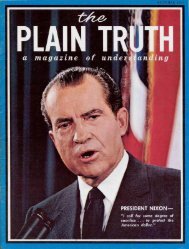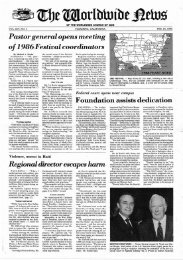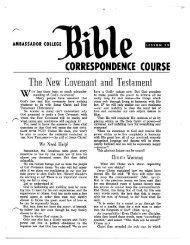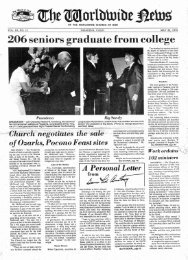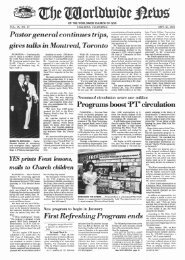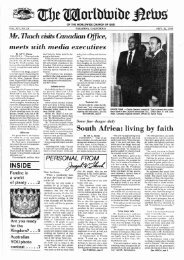Plain Truth 1959 (Vol XXIV No 03) Mar - Herbert W. Armstrong
Plain Truth 1959 (Vol XXIV No 03) Mar - Herbert W. Armstrong
Plain Truth 1959 (Vol XXIV No 03) Mar - Herbert W. Armstrong
Create successful ePaper yourself
Turn your PDF publications into a flip-book with our unique Google optimized e-Paper software.
<strong>Mar</strong>ch, <strong>1959</strong><br />
Six Articles Act. It maintained a strict<br />
doctrine of transubstantiation, vows of<br />
chastity, auricular confession and other<br />
Catholic practices (Fisher, The Reformation,<br />
p. 324).<br />
Meanwhile, however, he proceeded to<br />
complete the confiscation of all the monasteries<br />
in 1539, and strengthen his<br />
position as head of the church and state.<br />
His sharing of the seized wealth of the<br />
ecclesiastical properties built up the fortunes<br />
of the Protestant ruling class<br />
whose personal interests now lay in continued<br />
separation from Rome.<br />
The true fact is that they were<br />
Catholics in doctrine but Protestant in<br />
their confirmation of Henry's right to<br />
substitute himself for the pope as head<br />
of the church and to share with them<br />
the booty of the plundered monasteries.<br />
King Henry's <strong>Mar</strong>ital Escapades<br />
As "supreme Head" of the church of<br />
England, Henry's conduct toward his<br />
enemies and, strangely, even toward his<br />
wives, was as far removed from Christian<br />
principles as would seem possible.<br />
In the summer of 1535, he cruelly<br />
executed two of England's ablest scholars<br />
and theologians, Bishop John Fisher and<br />
Sir Thomas More, because they refused<br />
to endorse his supremacy over the<br />
church and clergy of England. Many<br />
Other notable persons paid with their<br />
lives for disagreeing with Henry's views.<br />
A helpful summary of Henry's vicious<br />
conduct toward his wives and nobles is<br />
given by Alzog:<br />
"Henry was as atrociously cruel to his<br />
wives as he was to his ministers and<br />
other subjects of inferior degree. Catharine<br />
of Aragon survived her repudiation<br />
a little less than three years, dying<br />
a most exemplary death, January 8,<br />
1536. She was hardly laid in her grave,<br />
when Anne Boleyn, who had taken her<br />
place in her husband's affections, and<br />
was the cause of all her misfortunes,<br />
was tried on the charges of adultery,<br />
incest, and high treason, declared guilty,<br />
and beheaded on the green within the<br />
Tower, May 19, 1536. Cranmer, who<br />
had formerly, 'in virtue of his apostolic<br />
authority,' pronounced the marriage between<br />
Henry and Anne lawful and valid,<br />
was now called upon to reverse his<br />
former decision, and, 'in the name of<br />
Christ and for the glory of God,' de-<br />
The PLAIN TRUTH<br />
clared that the same marriage was and<br />
always had been null and void. On the<br />
day of Anne's execution, as if to express<br />
his contempt for her memory, Henry<br />
dressed himself in a suit of white, and<br />
on the following morning was married<br />
to Jane Seymour, who died (October<br />
24, 1537) in less than a fortnight after<br />
giving birth to a male child, subsequently<br />
known as Edward VI. Henry was next<br />
married to Anne of Cleves in the beginning<br />
of the year 1540. The marriage<br />
was a political one, brought about<br />
through the agency of Thomas Cromwell,<br />
who hoped to strengthen the<br />
Protestant cause in England and prop<br />
up his own power through the influence<br />
of the new queen, who was known to<br />
be a thorough-going Lutheran. Deceived<br />
as to her beauty and personal attractions,<br />
Henry married her only because he<br />
could not well help himself, and, after<br />
living with her six months, procured a<br />
divorce mainly on these grounds (July<br />
13 ). Within a month (August 8) he<br />
married Catherine Howard, who, being<br />
shortly after charged with having committed<br />
adultery, was pronounced guilty,<br />
and beheaded February 13, 1541. Henry's<br />
sixth and last wife, Catharine Parr,<br />
was on one occasion nearly losing her<br />
head for venturing to differ on theological<br />
questions with the Head of the<br />
Church of England; but quickly detecting<br />
her mistake, she escaped the royal<br />
vengeance by adroitly flattering his great<br />
wisdom and theological learning, expressing<br />
her most humble submission to<br />
his judgment, and professing that in<br />
differing from him she had only desired<br />
to draw him into a heated discussion,<br />
because when animated, he seemed to<br />
forget the pain of the malady from<br />
UND JETZT INS<br />
DEUTSCHE OBERSETZTl<br />
Die Broschiiren<br />
"Wie oft sollren wir das heilige<br />
ABENDMAHL nehrnen?"<br />
"WOZU sind wir geboren?"<br />
"Die AUFERSTEHUNG war<br />
nicht an einem Sonntag!"<br />
sind erschienen!<br />
Postanschrift:<br />
Die Welt von Morgen<br />
P.O. Box 1<strong>03</strong>0<br />
Pasadena, Kalifornien<br />
Page 13<br />
which he was suffering. By this clever<br />
expedient, Catharine kept her head On<br />
her shoulders, and had the good fortune<br />
to outlive the brutal monster, who died<br />
in 1547.<br />
"Henry reigned for thirty-eight years,<br />
and during that time he ordered the<br />
execution of two queens, two cardinals,<br />
two archbishops, eighteen bishops,<br />
thirteen abbots, five hundred priors and<br />
monks, thirty-eight doctors of divinity<br />
and laws, twelve dukes and earls, one<br />
hundred and sixty-four gentlemen, one<br />
hundred and twenty-four commoners,<br />
and one hundred and ten ladies" (Alzog,<br />
Manual of Universal Church History,<br />
vol. III, pp. 322-3).<br />
Protestantism Advanced Under<br />
Edward VI<br />
At the death of Henry VIII, the great<br />
body of Englishmen stood with the late<br />
king in desiring no considerable change<br />
in doctrine or worship (Walker, p.<br />
408). But despite this fact England was<br />
to witness the introduction of many<br />
Lutheran teachings during the reign of<br />
Edward VI.<br />
Upon his ascension, Edward was only<br />
nine years of age. The Duke of Somerset<br />
was immediately created Protector<br />
and headed the governmental council.<br />
He was a man of Protestant sympathies<br />
and was a friend of the dispossessed<br />
lower agricultural classes.<br />
Under the influence of Somerset and<br />
Archbishop Cranmer, a number of<br />
changes in doctrine and worship were<br />
introduced.<br />
It was at this time that the Six Artides<br />
were repealed and the real basic<br />
doctrines of the Church of England were<br />
framed. Cranmer was a thorough-going<br />
Protestant in his sympathies, and<br />
brought over a number of Lutheran<br />
theologians for advice and counsel.<br />
Laws enforcing the celibacy of the<br />
priesthood were now repealed. Communion<br />
with both the bread and wine<br />
for the congregation was introduced,<br />
following Luther. The use of English in<br />
the church services was made mandatory,<br />
and help in formulating prayer<br />
books and liturgies was given by the<br />
continental reformers" (Fisher, The<br />
History of the Christian Church, pp.<br />
357-8).<br />
During this period, the basis of








